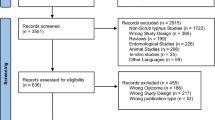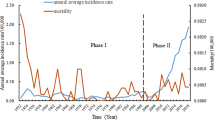Abstract
MITE-BORNE scrub typhus (tsutsugamushi disease) was a serious military problem in the Japanese campaign, and units unlucky enough to strike endemic foci suffered heavily1. The epidenir iology of the disease was investigated in North Burma by the U.S. Typhus Commission, and in the Imphal area (Manipur, Assam) by a team based on the Scrub Typhus Research Laboratory, which attempted to do complementary work, particularly on the ecology of the disease.
This is a preview of subscription content, access via your institution
Access options
Subscribe to this journal
Receive 51 print issues and online access
$199.00 per year
only $3.90 per issue
Buy this article
- Purchase on SpringerLink
- Instant access to full article PDF
Prices may be subject to local taxes which are calculated during checkout
Similar content being viewed by others
References
Buxton, P. A., Nature, 155, 643 (1945).
Gater, B. A. R., Parasitology, 24 (2), 149 and 163 (1932).
Author information
Authors and Affiliations
Rights and permissions
About this article
Cite this article
AUDY, J. SCRUB TYPHUS AS A STUDY IN ECOLOGY*. Nature 159, 295–296 (1947). https://doi.org/10.1038/159295a0
Issue date:
DOI: https://doi.org/10.1038/159295a0
This article is cited by
-
Ecological and behavioural risk factors of scrub typhus in central Vietnam: a case-control study
Infectious Diseases of Poverty (2021)
-
Scrub typhus ecology: a systematic review of Orientia in vectors and hosts
Parasites & Vectors (2019)



